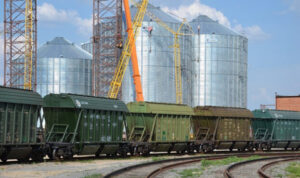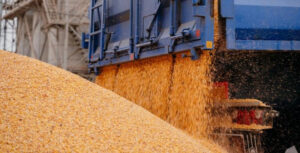
Lithuania has agreed on a corridor for the transit of Ukrainian grain to Baltic ports, Lithuanian Foreign Minister Gabrielius Landsbergis said.
“Russia destroys food, Lithuania delivers it. A corridor for grain transit to Baltic ports has been approved and agreed upon, which eases pressure on the Ukrainian border and increases supplies to Africa and beyond. Cooperation gives results!” he wrote on Twitter.
Earlier, it was reported that veterinary, sanitary and phytosanitary control would be moved from the Ukrainian-Polish border to the port of Klaipeda (Lithuania) for all agricultural cargoes heading to this port within two days. This will speed up transit through Poland.

Moldova has been offering assistance with the transit of Ukrainian grain since the beginning of the war, and now it is trying to find a solution that will suit Moldovan farmers and help Kiev, Moldovan President Maia Sandu has said.
Speaking about the situation with Ukrainian grain, Sandu called it a “complicated topic.”
“We are trying to find a solution. There are discussions with Ukraine, Romania and the European Commission to see how we can harmonize the interests of Moldovan farmers, but also ensure this transit of grain from Ukraine. We have an obligation to help Ukraine, which today provides for our peace,” she told RFI.
According to her information, Moldova will try to find the best solution for both sides. One of them is rapid investment in transportation and port infrastructure to increase capacity for this period.
“We want to increase our exports, we want to develop our infrastructure, and we can do it, in particular with the resources of the European Union,” she explained.
Sandu spoke about the problem of farmers in Moldova who, even before the war in Ukraine, did not have enough capacity to export.
“We have to state that the railroad and port infrastructure in Moldova is underdeveloped. Now, when these large volumes are coming from Ukraine, the situation has become more complicated,” Sandu said.
As reported, Moldova intends to modernize the railway infrastructure and railway bed in order to increase exports of Ukrainian agricultural goods, for which it cooperates with Romania, Ukraine and donor organizations.

Transit of Ukrainian grain through Poland is steadily growing: if in February it was 114 thousand tons, in June it exceeded 260 thousand tons, Polish Minister of Agriculture and Rural Development Robert Telusz said after online talks on Wednesday with Ukrainian Minister of Agrarian Policy Mykola Solskiy.
“This is very good news for agrarians, because grain from Ukraine does not enter the Polish market,” the Polish minister was quoted as saying in a tweet and on the ministry’s website.
At the same time, he said he saw a chance for the European Commission to extend the decision to ban Ukrainian grain exports to Poland after September 15, blaming both those in power in the EU and the Polish opposition for trying to destabilize Poland.
“It is in our interest to protect the Polish farmer. That is why a clear statement was made by Prime Minister Morawiecki that Ukrainian grain will not enter Poland after September 15,” Telusz reiterated.
According to him, the Polish side wants the so-called “solidarity corridors” to work effectively, which would allow for efficient transportation of Ukrainian goods without harming the Polish agricultural sector.
A press release from the Polish ministry indicates that to this end Telusz proposed measures to facilitate the transit of Ukrainian grain to seaports in various EU countries, in which Solsky was interested, but no other details are available and the Ukrainian ministry has not officially commented on the talks.
The Polish Ministry of Agriculture said that the Ukrainian side will also present a draft of detailed solutions in the near future. “He (Solsky – IF-U) explained that Russian missile strikes on Ukraine’s port infrastructure have put Ukrainian exporters in a very difficult situation. Now they will have to organize grain exports via other routes,” the release said.
Telush informed about ongoing negotiations with Lithuania and Latvia on the use of their ports for grain exports from Ukraine. “These negotiations are going in the right direction,” the minister added.
According to him, Poland has managed to significantly increase grain exports through its four main ports this year. In particular, if in January it amounted to 299 thousand tons, in February – 539 thousand tons, in March – 628 thousand tons, in April – 704 thousand tons, in May – 882 thousand tons, and in June – almost 940 thousand tons.
Poland exported more than 4.5 million tons of crops in 4 months of this year, stated Telusz.
It is noted that the ministers also raised the issue of access of Polish poultry products and eggs to the Ukrainian market, and currently the veterinary services of both countries are working intensively to resolve this issue.
The Polish Ministry of Agriculture pointed out that Ukraine is an important partner of Poland in agri-food trade. In 2022, an increase in agricultural exports to the Ukrainian market by 16% to $945.3 million was recorded. The main export items were: cheese and cottage cheese, products used for animal feed, and coffee. In April 2023, exports of agricultural products to the Ukrainian market increased by more than 35% compared to the same period in 2022, the release added.

Agrarian ministers of Moldova, Romania and Ukraine in online talks on Friday agreed to exchange information on the amount of wheat to be transported through solidarity corridors, the official website of Moldova’s agrarian ministry reported.
“The purpose of the meeting of the three parties was to agree on a way to organize in order to optimize the transit of grain coming from Ukraine so that Romanian agrarians can transport grain, release warehouses and export products of the new harvest,” the report said.
According to the press service of the Ukrainian ministry, Minister of Agrarian Policy Mykola Solskyi paid special attention to the discussion of transit of Ukrainian agricultural products on the territory of Moldova and Romania.
The trilateral meeting was preceded by negotiations of Romanian Deputy Prime Minister and Minister of Agriculture Vladimir Bol with his Moldovan counterpart Petre Dea. They discussed Moldovan-Romanian cooperation in the agro-industrial sector, mechanisms of financial and non-financial incentives for agricultural producers, as well as the portfolio of projects that are already implemented and planned for implementation.

From Monday, April 24, Romania will start sealing vehicles carrying Ukrainian agricultural products in transit, Ukrtransbesecurity reported in a telegram on Sunday following a meeting between Ukrainian Agrarian Policy Minister Mykola Solskyi and his Romanian counterpart Petru Dea.
“The Romanian customs authorities will install seals on trucks with Ukrainian agricultural transit goods,” the release said.
According to it, it is important for carriers transiting through Romania to prepare a truck for sealing and to arrive at the border only after fulfilling the relevant conditions.
Earlier this week, similar requirements for the sealing of transit Ukrainian agricultural road freight were introduced by Poland

Romania, Hungary and Slovakia will not limit the transit of agricultural products from Ukraine, but negotiations continue on the issue of imports into the countries’ territory. Imports into Poland in transit mode will resume with a T1 declaration, with the use of the SENT system to track the movement of cargo through Poland and cargo seals, said Agrarian Policy Minister Mykola Solsky at an extraordinary meeting of the Coordinating Council under the Agrarian Policy Ministry on Tuesday evening.
According to him, shipments of agricultural products, which will be delivered to Poland in transit, will continue to move across the country’s territory at 00:00 on April 21, accompanied by Polish customs officers.
The issue of transit by rail with the transshipment from wide-rail wagons (for tracks 1520 mm) to narrow-rail (for tracks 1435 mm) is still open. Market participants are expected to receive details of the procedure tomorrow at the Coordinating Council of the Ministry of Agriculture, which is scheduled for 10:30 a.m.
The ban on imports of agricultural products in accordance with the list in the annex to the order of the Minister of Development and Technology of Poland Waldemar Buda from April 15, 2023 has not been canceled.
Earlier it was reported that Ukraine and Poland agreed on the resumption of transit of banned for importation agricultural products: it will work at night from April 20 to April 21, 2023. Additional control measures will be applied to the transit. According to the Ministry of Agriculture of Poland, customs, tax and other services will accompany the transport to its destination. In addition, the SENT mechanism and electronic seals will be applied, by means of which each consignment of goods will be tracked.
Poland on April 15, after the farmers’ congress, made a unilateral decision to temporarily prohibit the import of any agricultural products from Ukraine until June 30, 2023. This happened despite the fact that on July 7, a bilateral agreement was reached with Ukraine on the temporary suspension of exports of only four crops – wheat, corn, rapeseed and sunflower, while transit continued, but with stricter conditions, which the parties planned to agree on quickly.
Hungary and Slovakia made similar decisions afterwards.